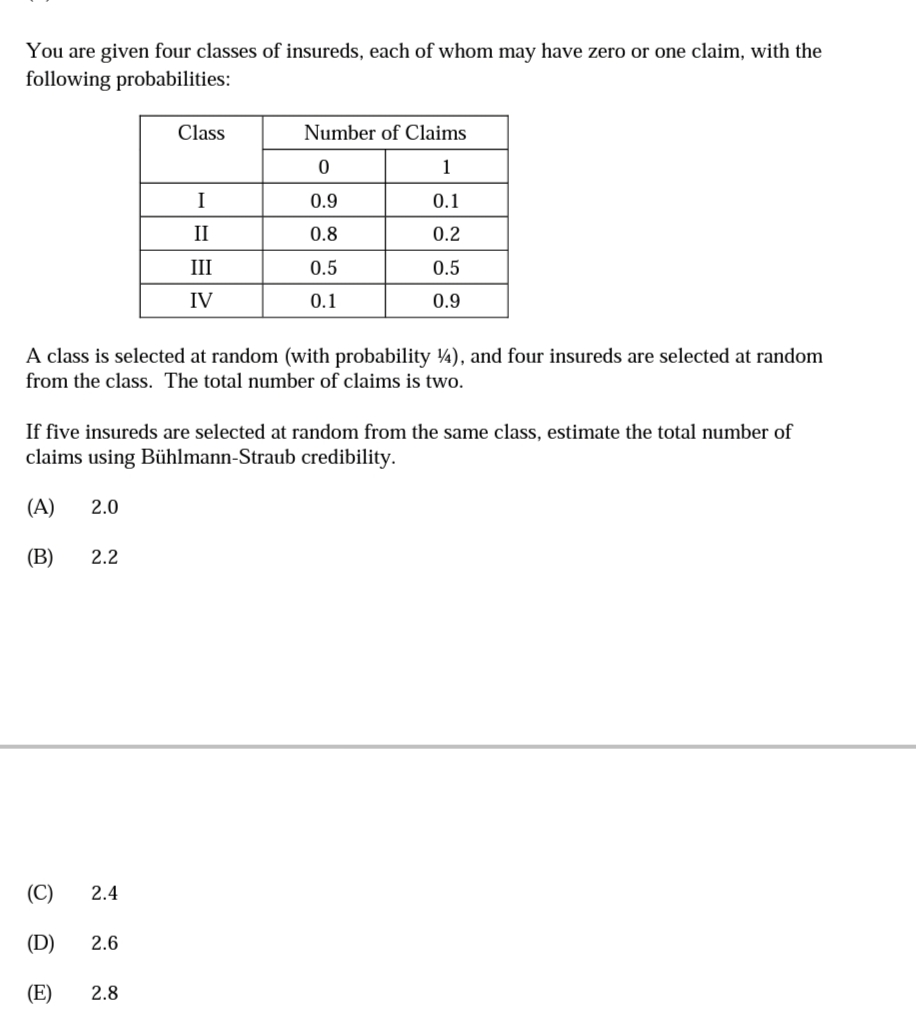You are given four classes of insureds, each of whom may have zero or one claim, with the following probabilities: Class Number of Claims 1 I 0.9 0.1 II 0.8 0.2 III 0.5 0.5 IV 0.1 0.9 A class is selected at random (with probability 4), and four insureds are selected at random from the class. The total number of claims is two. If five insureds are selected at random from the same class, estimate the total number of claims using Bühlmann-Straub credibility. (A) 2.0 (B) 2.2 (C) 2.4 (D) 2.6 (E) 2.8
You are given four classes of insureds, each of whom may have zero or one claim, with the following probabilities: Class Number of Claims 1 I 0.9 0.1 II 0.8 0.2 III 0.5 0.5 IV 0.1 0.9 A class is selected at random (with probability 4), and four insureds are selected at random from the class. The total number of claims is two. If five insureds are selected at random from the same class, estimate the total number of claims using Bühlmann-Straub credibility. (A) 2.0 (B) 2.2 (C) 2.4 (D) 2.6 (E) 2.8
Holt Mcdougal Larson Pre-algebra: Student Edition 2012
1st Edition
ISBN:9780547587776
Author:HOLT MCDOUGAL
Publisher:HOLT MCDOUGAL
Chapter11: Data Analysis And Probability
Section11.8: Probabilities Of Disjoint And Overlapping Events
Problem 2C
Related questions
Question

Transcribed Image Text:You are given four classes of insureds, each of whom may have zero or one claim, with the
following probabilities:
Class
Number of Claims
1
I
0.9
0.1
II
0.8
0.2
III
0.5
0.5
IV
0.1
0.9
A class is selected at random (with probability ¼), and four insureds are selected at random
from the class. The total number of claims is two.
If five insureds are selected at random from the same class, estimate the total number of
claims using Bühlmann-Straub credibility.
(A)
2.0
(B)
2.2
(C)
2.4
(D)
2.6
(E)
2.8
Expert Solution
This question has been solved!
Explore an expertly crafted, step-by-step solution for a thorough understanding of key concepts.
This is a popular solution!
Trending now
This is a popular solution!
Step by step
Solved in 2 steps with 2 images

Recommended textbooks for you

Holt Mcdougal Larson Pre-algebra: Student Edition…
Algebra
ISBN:
9780547587776
Author:
HOLT MCDOUGAL
Publisher:
HOLT MCDOUGAL

Elementary Linear Algebra (MindTap Course List)
Algebra
ISBN:
9781305658004
Author:
Ron Larson
Publisher:
Cengage Learning

College Algebra
Algebra
ISBN:
9781305115545
Author:
James Stewart, Lothar Redlin, Saleem Watson
Publisher:
Cengage Learning

Holt Mcdougal Larson Pre-algebra: Student Edition…
Algebra
ISBN:
9780547587776
Author:
HOLT MCDOUGAL
Publisher:
HOLT MCDOUGAL

Elementary Linear Algebra (MindTap Course List)
Algebra
ISBN:
9781305658004
Author:
Ron Larson
Publisher:
Cengage Learning

College Algebra
Algebra
ISBN:
9781305115545
Author:
James Stewart, Lothar Redlin, Saleem Watson
Publisher:
Cengage Learning